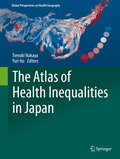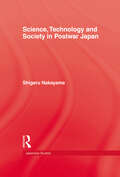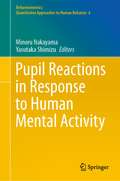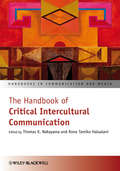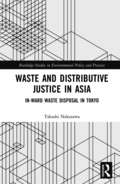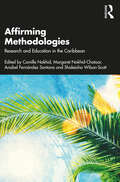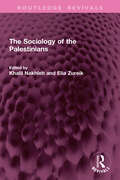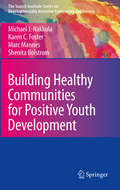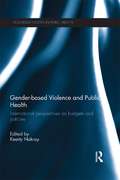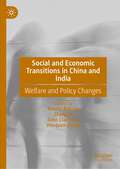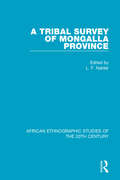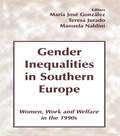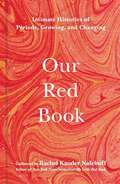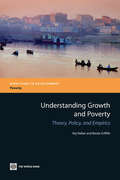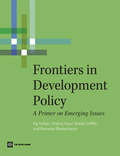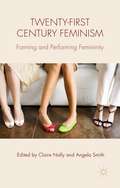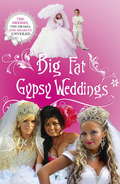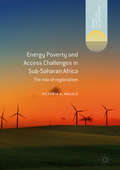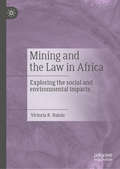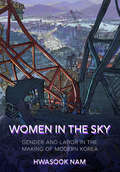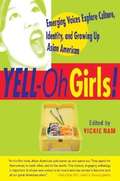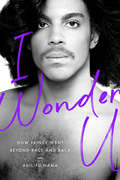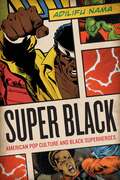- Table View
- List View
The Atlas of Health Inequalities in Japan (Global Perspectives on Health Geography)
by Tomoki Nakaya Yuri ItoThis new health atlas of Japan presents a series of maps about the health of the contemporary Japanese population, i.e. detailed maps of health indicators in small areas using cartograms. This is the first comprehensive small-area based health atlas about contemporary Japan using vital statistics from 1995-2014. Each map is supplemented with concise explanations written by leading epidemiologists and health geographers in Japan. The book employs various cutting-edge methods in spatial epidemiology, Bayesian spatial smoothing for the reliable mapping of mortality indices, advanced cartographic transformations using the concept of aerial cartograms, and summary statistics of socioeconomic health inequalities. The atlas highlights geographical aspects of social gradients in health by comparing mortality maps with distribution of deprivation index during the recent long-lasting economic stagnation period of Japan known as the lost decades. This health atlas will be a useful resource for international comparisons between Japan and other advanced countries in terms of health and related socioeconomic disparities between regions. It will be of interest to public health practitioners, administrators, researchers and students working on health geography and public health.
Science Technology & Society
by NakayamaFirst published in 1991. Routledge is an imprint of Taylor & Francis, an informa company.
Pupil Reactions in Response to Human Mental Activity (Behaviormetrics: Quantitative Approaches to Human Behavior #6)
by Minoru Nakayama Yasutaka ShimizuThis book focuses on a development for assessing mental changes using eye pupil reactions, namely extracting emotional change from the response to evaluate the viewer's interest in visual information. The pupil of the eye reacts to both brightness and emotional state, including interest, enjoyment, and mental workload. Because pupillary change is a biological signal, various artifacts influence measurements of eye images. Technical procedures are required to extract mental activities from pupillary changes, and they are summarized here step by step, although some procedures contain earlier techniques such as analog video processing. This study examines the possibility of estimating the viewer's interest and enjoyment of viewing movies by measuring the dynamic pupillary changes, blinking, and subjective interest responses. In evaluation of pupil size, there was a significant difference in pupil size between the higher and the lower shot for the degree of subject interest response in each kind of movies. The first part of the book shows a pupil reaction model for brightness changes to extract mental activities. Pupil reactions were observed for various visual stimuli in brightness changes. With regard to the characteristics of pupillary changes, a model with a three-layer neural network was developed and the performance was evaluated. Characteristics of pupil reactions during model development are summarized here. The second part examines the possibility of estimating the viewer's interest and enjoyment of television programs by measuring dynamic pupillary changes, blinking, and subjective interest responses. The final part describes a development of estimation model of pupil size for blink artifact. The model development was able to estimate pupillary changes and pupil size while the viewer was blinking and was applied to pupillary changes in viewing television programs.
The Handbook of Critical Intercultural Communication (Handbooks in Communication and Media #19)
by Thomas K. Nakayama Rona Tamiko HalualaniThe Handbook of Critical Intercultural Communication aims to furnish scholars with a consolidated resource of works that highlights all aspects of the field, its historical inception, logics, terms, and possibilities. A consolidated resource of works that highlights all aspects of this developing field, its historical inception, logics, terms, and possibilities Traces the significant historical developments in intercultural communication Helps students and scholars to revisit, assess, and reflect on the formation of critical intercultural communication studies Posits new directions for the field in terms of theorizing, knowledge production, and social justice engagement
Waste and Distributive Justice in Asia: In-Ward Waste Disposal in Tokyo (Routledge Studies in Environmental Policy and Practice)
by Takashi NakazawaConflicts over waste disposal facility siting is a pressing issue not only in developed countries but also in fast-growing countries that face drastic waste increase and rapid urbanisation. How to address distributive justice has been one of the biggest concerns. This book examines what determines the influence of distributive justice in siting policy. In the 23 wards of Tokyo, one idea of distributive justice, known as "In-Ward Waste Disposal" (IWWD), emerged amid the ongoing garbage crisis in the early 1970s. IWWD was adopted as a significant principle, but its influence waxed and waned over time, until the idea was finally abandoned in 2003. To unravel causes and mechanisms behind the changing influence of IWWD, this book adopts a framework that considers not only ideational causes, but also the power struggles between rationally calculating actors, as well as the influence of external events and environments. By combining an in-depth case study with an integrative theoretical framework, this book tells a thought-provoking story of the changing influence of IWWD in a deep, comprehensive and consistent way. This book provides significant insights and lessons for both academics and practitioners.
Affirming Methodologies: Research and Education in the Caribbean
by Camille NakhidAffirming Methodologies: Research and Education in the Caribbean centres local and indigenous ways of knowing in research and education praxis in the Caribbean. The research methodologies and pedagogies are presented in this book within an Affirming Methodologies framework. They bring forward localized epistemologies whereby Caribbean ways of being and knowing are affirmed, and the expected western hierarchies between researcher and researched are removed. The chapters present approaches to knowledge construction and knowledge sharing based on practices, lived experiences, traditions, language patterns, and rituals of Caribbean communities. The importance of an Affirming Methodologies approach is demonstrated, and the characteristics of culturally affirming research methodologies and pedagogies in diverse environments including Cuba, Trinidad and Tobago, Jamaica and the Caribbean diaspora in Aotearoa New Zealand and Canada are explored and presented. Grounded on an understanding of the authors’ Caribbean positionality, ontological distinctions within the Caribbean research context are considered. This book moves forward from a decolonizing methodology approach, and, as such, the chapters are written, not in opposition to, or tested against Eurocentric approaches to research, but deeply rooted in a Caribbean ethos. This book will engage researchers (both qualitative and quantitative), postgraduate students, academics, practitioners, policymakers, community workers, and lay persons who seek to employ culturally relevant local and indigenous research approaches in their work. Each chapter offers practical suggestions on the 'how' of research practice, making them accessible, relevant, and flexible for novice and seasoned researchers alike.
The Sociology of the Palestinians (Routledge Revivals)
by Khalil Nakhleh Elia ZureikFirst published in 1980, The Sociology of the Palestinians is a comprehensive collection of sociological and demographic studies of the Palestinian people. One paper deals with the Palestinian Arabs in pre-1967 Israel and the various methods of social control adopted by the Zionist regime to co-opt and control the Arab population. A second paper focuses on the Palestinians in the West Bank and Gaza. An analysis of current Palestinian demography with projections for the future is made, and the minority position of the Palestinians in the Arab World is critically assessed. An examination of the role of Palestinian intellectuals is followed by a theoretical discussion on the development of Palestinian class structure. Finally, the role of Palestinian women is examined in the context of traditional social structure and the specific political and economic situation which confront Palestinian society. This book will be of interest to students of history, sociology, and political science.
Building Healthy Communities for Positive Youth Development (The Search Institute Series on Developmentally Attentive Community and Society #7)
by Michael J. Nakkula Shenita Bolstrom Marc Mannes Karen C. FosterThe Healthy Communities Healthy Youth (HC HY) project has provided grassroots support for the creation of robust, welcoming environments not only for children and adolescents at risk but for all youth. Building Healthy Communities for Positive Youth Development explains the Developmental Assets framework in depth and demonstrates how eight local initiatives across the country have adapted and implemented it to fit the unique cultures and resources of their neighborhoods and the needs and strengths of their young people. Stakeholders collaborating in the process include parents, educators, politicians, service providers, law enforcement, volunteers, and?as active participants instead of merely recipients of services?youth themselves. In this visionary book, the authors provide readers with a flexible, living blueprint for promoting the well-being of children and teenagers. Areas of coverage include: Core themes of the eight HC HY initiatives. The use of an asset-based common language among participants. Building common ground among the various sectors involved in the initiatives. The varied roles of young people within the initiatives. Research design and methodology; data collection and interpretation. Funding issues and challenges. The mission outlined in Building Healthy Communities for Positive Youth Development fits the interests of a wide range of professionals, including developmental psychologists; child, youth, and family service professionals; clinical child and school psychologists; and allied education and mental health practitioners working with children and adolescents.
Gender-based Violence and Public Health: International perspectives on budgets and policies
by Keerty NakrayGender-based violence is a multi-faceted public health problem with numerous consequences for an individual’s physical and mental health and wellbeing. This collection develops a comprehensive public health approach for working with gender-based violence, paying specific attention to international budgets, policies and practice and drawing on a wide selection of empirical studies. Divided into two parts, the text looks at how public health budgets and policies can be used to influence a range of risk factors and outcomes, and then outlines a theoretical and conceptual framework. The second section draws on empirical studies to illustrate ways of managing the risks and impacts of, and responses to, the problem. It concludes by summarising those risk factors that can be effectively addressed through appropriately budgeted public health programmes globally. Highlighting ways of bolstering protective and resilience factors and identifying early interventions, it demonstrates the importance of inter-agency interventions through coordinated effort from a wide range of sectors including social services, education, religious organisations, judiciary, police, media and business. This inter-disciplinary volume will interest students and researchers working on gender-based violence, gender budgeting and public health policy from a range of backgrounds, including public health, sociology, social work, public policy, gender studies, development studies and economics.
Social and Economic Transitions in China and India: Welfare and Policy Changes
by Keerty Nakray Zhang Yi John Clammer Wenjuan ZhangThis book conducts a comparative analysis of social and economic changes in the welfare state transformations in China and India, at national and sub-national levels. Discussions are made based on impacts from the social and economic changes in the last century and the fourth industrial revolution on welfare state transformations in China and India, the world's two largest countries in terms of population and density.First-hand empirical work is conducted by a group of scholars from India and China, which draws on inter-disciplinary and cross-cultural academic traditions to deepen social, cultural and legal understanding between the two countries.This book would appeal to undergraduate and graduate students in comparative sociology, political science, law and comparative welfare studies as well as researchers in these fields, as well as researchers in policy think-tanks and research institutes and officials in government and non-governmental organizations.
A Tribal Survey of Mongalla Province
by L. F. NalderOriginally published in 1937, this book describes and compares the tribes of the Mongalla Province in what is now South Sudan. In the second part of the book some 27 individual tribes are discussed in detail, and topics such as linguistics, culture, tribal structure, religious beliefs, crime and punishment, marriage, birth, burial and economic and agricultural life are also covered.
Gender Inequalities in Southern Europe: Woman, Work and Welfare in the 1990s
by Manuela Naldini María José González Teresa JuradoPresenting studies of the situation on gender inequalities and associated pattern of work and welfare in all southern European countries, this work focuses on the interaction of the three major societal institutions - the State, the family and the labour market.
Our Red Book: Intimate Histories of Periods, Growing & Changing
by Rachel Kauder NalebuffA collection of essays, oral histories, and artworks about periods across all stages of life, gathered by the editor of the New York Times bestselling anthology My Little Red Book.After hearing a harrowing coming-of-age story from her great aunt, Rachel Kauder Nalebuff started gathering stories about menstruation in her family that had never been told. What began as an oral history project quickly snowballed: Rachel heard from family and friends, and then from strangers—writers, experts, community leaders, activists, young people, and other visionaries—about the most intimate physical transformations in their lives. Our Red Book takes us through stories of first periods, last periods, missing periods, and everything about bleeding that people wish they had been told. Weaving together powerful voices—from teenagers, midwives, Indigenous scholars, Olympic athletes, incarcerated writers, disoriented fathers, elected leaders who fought to make period products free, friends transitioning genders, grandmothers, and lovers—the book invites us on a collective journey of growth and change, with Rachel&’s own voice as a guide. The result is a people&’s history of menstruation, told through an array of perspectives and identities that span the globe. Gathered over twenty years, the collection takes stock of our shifting relationships to family, cultural inheritance, gender, aging, and liberation.
Understanding Growth and Poverty
by Raj Nallari Breda GriffithThe literature on growth and poverty is voluminous and still evolving. This title distills the most important lessons from developing countries' experience with growth and poverty. It provides a broad understanding of the impact of economic policies on growth and poverty reduction in developing countries. After describing basic economic relationships that summarize the workings and the measurement of the macroeconomy--and after confirming that growth is the most critical factor in alleviating poverty--the book turns to individual policy areas. These include the various roles of government, among them setting fiscal policy and maintaining an environment conducive to the effective operation of a market economy. Policies governing money supply, exchange rates, and the financial sector are also covered. After assessing several decades of experience with development assistance, the aim of which has been to place poor countries on a path of sustainable long-run growth, the study turns to a discussion of external debt. In the 1980s and 1990s, debt contracted by low-income countries from commercial and official sources became unsustainable, crippling their growth, keeping millions in poverty, and forcing an international reappraisal of lending policies, the centerpiece of which was a set of debt-forgiveness policies that was put forward with the launch of the Jubilee 2000 debt relief campaign. The remainder of the volume examines problems that can keep the poor from moving out of poverty. Trade, institutional development, regulation, education, health, labor markets, land and agriculture, natural resources, urbanization, technology, and politics-all are core components of public policy and need to be handled right if poverty is to be addressed effectively. Because many developing countries lack the capacity to mobilize resources-administrative and financial-to move the poor out of poverty, the international community must be actively involved. Looking ahead, rates of growth and poverty will be determined by how nations use knowledge, technology, and energy in firms and households, and by the effects of the warming climate on economic activities. Above all, the distribution of political and economic power within and among countries will determine the direction and dynamics of growth and development.
Frontiers in Development Policy
by Raj Nallari Shahid Yusuf Breda Griffith Rwitwika BhattacharyaThe global crisis of 2008-09 has brought to the forefront a plethora of economic and political policy issues. There is a re-opening of discussion on basic economic concepts, appropriate framework for analysis, role of private and public sectors in the economy, structural transformation of economies, human development and managing of growing risks and crises. The purpose of this book has been to bring home the inter-linkages in various parts of the economy and the need for practical policy making to reach development goals while being aware of the instabilities, complexities and downside risks inherent in the nature of a an economy operating in a globalized world. Thematically, this book focuses on two core types of policy: policies that promote strong, sustainable and inclusive growth in low income and middle income developing countries and new and emerging policies that necessitates a discussion amongst policy makers and practitioners. Throughout the book, the authors provide insight in to the different types of policy approaches that can be taken to help the economy grow. Ultimately the book looks to foster discussion amongst policy makers on growth and development.
Twenty-first Century Feminism
by Claire Nally Angela SmithThis collection of essays considers the ways in which feminism is still an important issue in twenty-first century society. Looking at various forms of literature, media, and popular culture, the book establishes that contemporary images of femininity are highly contested, complex, and frequently problematic.
Big Fat Gypsy Weddings: The Dresses, the Drama, the Secrets Unveiled
by Jim NallyBig Fat Gypsy Weddings has been the most talked-about show on TV and delivered ratings almost as enormous as the frothy, bejewelled frocks its subjects wear. <P><P>This book offers a window into the secret and surprising world of Gypsies and Travellers in Britain today. From spectacular first communions, strict courtings and jaw-dropping weddings, this book covers all the extraordinary rite-of-passage events in a Gypsy's life and offers an insight into their fascinating world. <P>All the favourite characters from the show are there - from Thelma the miracle dressmaker to Paddy, the champion bare-knuckle boxer. Warm, engrossing and funny, Big Fat Gypsy Weddings lays bare an exotic unseen Britain that exists right on our doorstep.
Energy Poverty and Access Challenges in Sub-Saharan Africa: The role of regionalism (Energy, Climate and the Environment)
by Victoria R. NaluleAccess to modern energy is central in addressing the major global challenges of the 21st century, including poverty, climate change and famine. However large parts of the world, especially in Sub-Saharan Africa (SSA) have poor or no access to modern energy. Victoria Nalule argues that SSA countries have many common energy challenges which could be tackled with collective efforts through regional cooperation. By means of a legal and comparative analysis and a seven-step framework, the book explores the current regional mechanisms employed in Africa to address the challenge of energy poverty and access and whether they are effective in tackling the challenge of energy access, including regional energy infrastructure and regional energy regulations.Chapters discuss the evolution of regionalism in SSA and the role of regional cooperation in the development of renewable energy as a means of confronting both energy access and climate change. Specifically the nexus between energy access, renewable energy and climate change is covered as well as the potential of fossil fuels in addressing energy poverty. The establishment and development of regional energy infrastructure as one of the mechanisms of addressing energy access challenges in SSA and regional efforts to harmonise energy regulation are explored. Finally a concluding chapter provides recommendations for policy makers and other relevant stakeholders on how best to implement some of the suggestions made in previous chapters. International organisations, regional organisations, government officials, scholars and students with interest in the energy sector will highly benefit from this book.
Mining and the Law in Africa: Exploring the social and environmental impacts
by Victoria R. NaluleThe mining sector has been an integral part of economic development in many African countries. Although minerals have been exploited for decades in these countries, the benefits have not always been as visible. This has necessitated reforms including nationalisation of mining activities in the distant past; and currently legal and regulatory reforms. This book gives an insight of these reforms and with reference to the fieldwork research undertaken by the author in some African countries, the book highlights the social and environmental impacts of mining activities in Africa. The central question of the book is, why the mining laws have worked in some countries but not others and what can be done to ensure that these laws are effective? Consequently, the book analyses the legal reforms made in the sector and highlights both the challenges and the opportunities for foreign investors as well as the African governments and local communities. The book will be of great interest to researchers and students in Energy and Geography related fields, as well as to practitioners and policy makers.
Renegotiating Contracts for the Energy Transition in the Extractives Industry (Just Transitions)
by Victoria R. Nalule Raphael J. Heffron Damilola S. OlawuyiThis book focuses on renegotiating extractive contracts to align with the net-zero goals. It delves into extractive contract negotiations in four ways which collectively represent a major research gap in literature. It focuses on extractive contract provisions and examines their alignment with net zero goals, suggesting how these provisions could be re-negotiated to ensure an effective energy transition. Consequently, the book assesses how contractual provisions are responding to, or reflecting energy transition scenarios, and highlights areas to be included or strengthened that will be beneficial for all energy stakeholders. This book goes on to discuss the energy transition global landscape. Through the presentation of case studies from different countries, the book assesses the transition risks in extractive contracts, and it uniquely provides the negotiation tools and strategies to address these transition risks.
Women in the Sky: Gender and Labor in the Making of Modern Korea
by Hwasook NamWomen in the Sky examines Korean women factory workers' century-long activism, from the 1920s to the present, with a focus on gender politics both in the labor movement and in the larger society. It highlights several key moments in colonial and postcolonial Korean history when factory women commanded the attention of the wider public, including the early-1930s rubber shoe workers' general strike in Pyongyang, the early-1950s textile workers' struggle in South Korea, the 1970s democratic union movement led by female factory workers, and women workers' activism against neoliberal restructuring in recent decades. Hwasook Nam asks why women workers in South Korea have been relegated to the periphery in activist and mainstream narratives despite a century of persistent militant struggle and indisputable contributions to the labor movement and successful democracy movement. Women in the Sky opens and closes with stories of high-altitude sit-ins—a phenomenon unique to South Korea—beginning with the rubber shoe worker Kang Churyong's sit-in in 1931 and ending with numerous others in today's South Korean labor movement, including that of Kim Jin-Sook.In Women in the Sky, Nam seeks to understand and rectify the vast gap between the crucial roles women industrial workers played in the process of Korea's modernization and their relative invisibility as key players in social and historical narratives. By using gender and class as analytical categories, Nam presents a comprehensive study and rethinking of the twentieth-century nation-building history of Korea through the lens of female industrial worker activism.
Yell-Oh Girls! Emerging Voices Explore Culture, Identity, and Growing Up Asian American
by Vickie NamThe collection includes 80 brief selections (most are under three pages) by budding writers between 15 and 22 years of age, from all over the country.
I Wonder U: How Prince Went beyond Race and Back
by Adilifu NamaIn 1993, Prince infamously changed his name to a unique, unpronounceable symbol. Yet this was only one of a long string of self-reinventions orchestrated by Prince as he refused to be typecast by the music industry’s limiting definitions of masculinity and femininity, of straightness and queerness, of authenticity and artifice, or of black music and white music. Revealing how he continually subverted cultural expectations, I Wonder U examines the entirety of Prince’s diverse career as a singer, multi-instrumentalist, songwriter, producer, record label mogul, movie star, and director. It shows how, by blending elements of R&B, rock, and new wave into an extremely videogenic package, Prince was able to overcome the color barrier that kept black artists off of MTV. Yet even at his greatest crossover success, he still worked hard to retain his credibility among black music fans. In this way, Adilifu Nama suggests, Prince was able to assert a distinctly black political sensibility while still being perceived as a unique musical genius whose appeal transcended racial boundaries.
Super Black: American Pop Culture and Black Superheroes
by Adilifu Nama&“A welcome overview of black superheroes and Afrocentric treatments of black-white relations in US superhero comics since the 1960s.&” –ImageTexT JournalWinner, American Book Award, Before Columbus FoundationSuper Black places the appearance of black superheroes alongside broad and sweeping cultural trends in American politics and pop culture, which reveals how black superheroes are not disposable pop products, but rather a fascinating racial phenomenon through which futuristic expressions and fantastic visions of black racial identity and symbolic political meaning are presented. Adilifu Nama sees the value—and finds new avenues for exploring racial identity—in black superheroes who are often dismissed as sidekicks, imitators of established white heroes, or are accused of having no role outside of blaxploitation film contexts.Nama examines seminal black comic book superheroes such as Black Panther, Black Lightning, Storm, Luke Cage, Blade, the Falcon, Nubia, and others, some of whom also appear on the small and large screens, as well as how the imaginary black superhero has come to life in the image of President Barack Obama. Super Black explores how black superheroes are a powerful source of racial meaning, narrative, and imagination in American society that express a myriad of racial assumptions, political perspectives, and fantastic (re)imaginings of black identity. The book also demonstrates how these figures overtly represent or implicitly signify social discourse and accepted wisdom concerning notions of racial reciprocity, equality, forgiveness, and ultimately, racial justice.&“A refreshingly nuanced approach . . . Nama complicates the black superhero by also seeing the ways that they put issues of post-colonialism, race, poverty, and identity struggles front and center.&” –Rain Taxi
Super Black: American Pop Culture and Black Superheroes
by Adilifu Nama&“A welcome overview of black superheroes and Afrocentric treatments of black-white relations in US superhero comics since the 1960s.&” –ImageTexT JournalWinner, American Book Award, Before Columbus FoundationSuper Black places the appearance of black superheroes alongside broad and sweeping cultural trends in American politics and pop culture, which reveals how black superheroes are not disposable pop products, but rather a fascinating racial phenomenon through which futuristic expressions and fantastic visions of black racial identity and symbolic political meaning are presented. Adilifu Nama sees the value—and finds new avenues for exploring racial identity—in black superheroes who are often dismissed as sidekicks, imitators of established white heroes, or are accused of having no role outside of blaxploitation film contexts.Nama examines seminal black comic book superheroes such as Black Panther, Black Lightning, Storm, Luke Cage, Blade, the Falcon, Nubia, and others, some of whom also appear on the small and large screens, as well as how the imaginary black superhero has come to life in the image of President Barack Obama. Super Black explores how black superheroes are a powerful source of racial meaning, narrative, and imagination in American society that express a myriad of racial assumptions, political perspectives, and fantastic (re)imaginings of black identity. The book also demonstrates how these figures overtly represent or implicitly signify social discourse and accepted wisdom concerning notions of racial reciprocity, equality, forgiveness, and ultimately, racial justice.&“A refreshingly nuanced approach . . . Nama complicates the black superhero by also seeing the ways that they put issues of post-colonialism, race, poverty, and identity struggles front and center.&” –Rain Taxi
